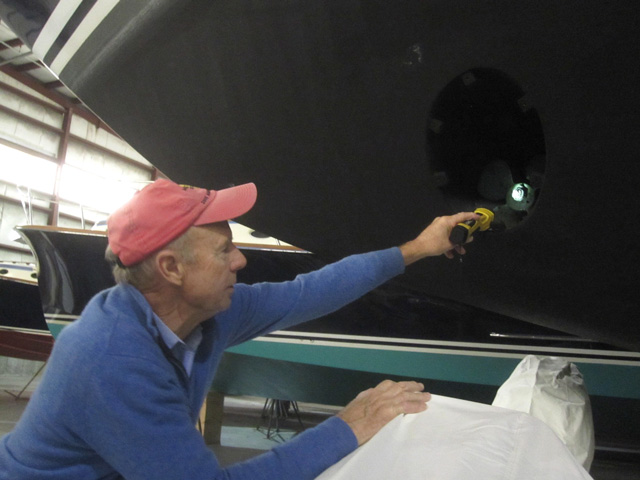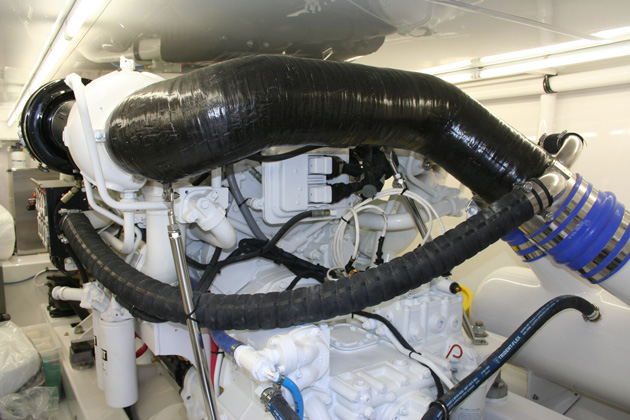Advertisement
Advertisement
Understanding Boat Surveys: What is Pre-Purchase?
Whether you’re buying or selling, the pre-purchase boat survey can make or break the deal.
May 19, 2021
In Understanding and Choosing Marine Surveyors we discussed the surveyors themselves, and the wide range of boat surveys they do – noting the importance of matching the surveyor to the specific boat. Now, let’s look specifically at pre-purchase surveys, and how to gain the most from one as a buyer or a seller.

The pre-purchase boat survey can make or break a deal, so you'll want to completely understand what's going on.
Say you’ve found the right boat and made an offer contingent upon a survey. Or you’re selling your boat and finally found a buyer at the right price. Now all you need to do is get past the dreaded survey. No matter which side of the negotiation you're on, it helps to understand the overall situation.
Surveyor's Perspective
For the surveyor, these can be the toughest assignments – not because of the boats, but because of the parties involved. The surveyor is hired by, and works for, the buyer. But the broker and owner are interested parties as well, and everyone wants the transaction to go through. Furthermore, the broker might refer clients to the surveyor every so often, and the seller might be a possible client for the surveyor when he or she buys their next boat. All of this sounds like a conflict of interest in the works, and abuses can happen (especially if a broker is adamant about a buyer using a particular surveyor). The Society of Accredited Marine Surveyors (SAMS) and National Association of Marine Surveyors (NAMS) organizations are well aware of this, and both have clear codes of ethics for their members.
The Process
Fortunately for all, there is a clear path forward; every boat comes with a work list and it’s a surveyor’s job to define what’s on that list as objectively as possible. It’s not the surveyor’s role to tell the buyer whether or not to buy, and overemphasizing minor problems could mislead the buyer just as much as ignoring them would. Experienced brokers know, too, that they don’t want to sell a boat that has problems. They want the new owner to be happy with the purchase because a happy owner is more likely to become a repeat customer. And owners are rarely surprised by survey findings – generally, they know their boat better than anyone.
Finally, if as the buyer you think pressuring the surveyor to overemphasize as many issues as possible will help drive the purchase price down, you might want to rethink that approach; the report written for this survey will also be the one you send to your insurance company. It may prompt an expensive list of work that’s required before a policy will be issued.
Survey Guidelines
There are guidelines used in the survey that help with many of the judgment calls; the surveyor is not just acting on his or her opinions. First and foremost is the Code of Federal Regulation (CFRs), often referred to as “Coast Guard regulations.” These cover minimal requirements for safety equipment, navigation lights, sanitation, engine, fuel and electrical systems on gasoline-powered boats. Diesel-powered boats are free from the mechanical and electrical regulations but still must comply with the others.
Close behind the CFRs are the American Boat and Yacht Council (ABYC) Standards, which are “recommendations” rather than regulations, but can carry significant weight if an accident or failure ends up in court. The standards are extensive to say the least (in book form they weigh four and a half pounds), and they cover just about everything on a boat except the basic design and construction. Fortunately, since the standards are so complete, many of the sections will not apply to one individual boat or another. But most systems a surveyor sees on a boat will have some relevant recommendations from ABYC.
Additional standards that surveyors cite come from the National Fire Protection Agency (NFPA), and in some specific cases, the surveyor might use other sources. For instance, it may be appropriate for a surveyor to judge the lifelines on a racing sailboat based on the Offshore Special Regulations, which set rules for offshore sailboat racing.
Are there still judgment calls? Certainly. The standards can’t help evaluate the significance of elevated moisture readings in a deck, or the level of wear in belts or hoses. And the toughest calls arise when a surveyor is faced with a system on an older model boat that doesn’t meet standards for boats built today. Is it wrong? Is it inherently dangerous? The answers almost always seem to start with, “It all depends...”
The Scope of a Pre-Purchase Survey
While a client is free to make any arrangements with a surveyor acting as his consultant, market forces have created a “normal” pre-purchase “condition and value” survey. It’s a nondestructive inspection of the boat to check its condition, check its systems for basic operation and adherence to applicable regulations and standards, look for any warning signs that might recommend a follow-on inspection by a specialist, and determine its overall value. In many ways, the process is analogous to a doctor giving a patient a physical—except for the appraisal.
The key point is that the survey is a limited inspection. This is the level of inspection that the market has become accustomed to paying for, which is also accepted by insurance companies. In general, the surveyor will not disassemble permanent parts of the boat to access areas they can’t see, so some areas won’t be inspected. And it’s a snapshot of the boat at that particular moment – there’s no guarantee that an electrical component that powered up during the survey won’t suddenly reach the end of its life the next week.
The classic survey routine for a boat in the water starts with an inspection in its slip, a “short haul” and bottom cleaning in the middle of the day, a hull inspection once the boat dries, re-launching and a short sea trial, followed by any further inspections needed. All of this is accomplished in one day on most boats, though on larger yachts more time may be needed. Also, while the routine above may be perfect for a powerboat in the water on a sunny day in Florida, it often needs to be modified based on weather, the yard’s schedule, and other variables. If it’s December in New England and the boat is stored on land for the season, it might even be necessary to do as much of the survey as possible on land right then, and save the final sea trial until the spring.

Especially on large inboard boats with expensive powerplants, an engine survey is a good idea.
Another variable is that the surveyor may suggest including an engine surveyor in the process as well. This is especially common (and wise) on larger powerboats where the engine(s) are a big part of the boat’s value. And on sailboats, some surveyors are willing to go up masts for rigging inspections if the client wishes, but that adds time and expense to the process as well.
The Report
The result of the surveying process will be a written report with:
- Descriptions of the boat and each system onboard.
- Findings and recommendations, divided into levels of importance.
- A statement of the boat’s overall condition.
- Fair market and replacement values for the boat, based on comparable sales or industry data.
The report will comment on the condition of the components on the boat, and may state whether the boat is “fit for its intended use,” but will not (and should not) say whether the boat is “seaworthy.” The concept of being “seaworthy” includes the quality of the crew and its preparations in relation to a specific voyage being attempted, so it's well outside the scope of a pre-purchase survey.
What does all this cost?
This is the toughest question of all. Some surveyors use a flat rate based on the length the boat, while others use an hourly rate. Either way, a pre-purchase survey will cost somewhere around $20 per foot, but it will be higher on large and complex (or older) boats. In some cases, it may be less. Remember, boats get large quickly—a boat that’s twice the length could have up to four times the surface area and eight times the volume.

When considering the cost of a survey, don't forget about expenses that may go with it - like a haul-out.
The location or time of year may have an effect on survey pricing as well. A “short haul” during the survey to powerwash the bottom and inspect the hull could add another $14 to $19 per foot, and an engine surveyor might add approximately $500 per engine.
The irony that I slipped in above is that older boats will likely cost more to have surveyed than new ones. A 2008 36’ sailboat being purchased for $200,000 is likely to be a much easier job for a surveyor than a similar boat from 1978 selling for a tenth of the price. When you call about the older boat, either the surveyors will give quotes that reflect this, or they’ll seem awfully busy and refer you to newer, younger surveyors in the area.
Getting the Most out of a Survey
Whether you’re buying or selling, you want to make sure you get the most value out of a survey.
As the Buyer:
- Let the surveyor know about any red flags for you: moisture, blisters, engine mounts—your experience and research are a key part of the process.
- If there’s some deficiency that would absolutely disqualify the boat in your mind, let the surveyor know to check that first. Surveys sometimes end abruptly, and it’s common for the surveyor and client to agree on some partial payment if a clear defect convinces the buyer that there’s no need to continue.
- Be there for at least part of the survey so the surveyor can show you findings in person.
- Help if you can, perhaps by pulling gear and cushions out of areas to be inspected.
- Don’t waste the surveyor’s time and attention with things you can survey yourself, like fishing gear, sails in bags, and other add-ons. This may help to reduce the cost of the survey as well.
- Write down questions to be asked when a good time arises—don’t distract the surveyor every time you see something to ask about.
As the Seller:
- Your preparation starts long before the survey. In the ideal world we should all be preparing to sell our boats as soon as we buy them.
- Keep a log with all invoices for maintenance and service work performed on the boat throughout its life. It’s hugely impressive for a surveyor to find this on a boat.
- Be careful about doing work on the boat yourself if it goes beyond cosmetics. As a surveyor, when you hear “the owner is very handy, and he’s done a lot of work on the boat himself,” it’s a red flag.
- Prior to the survey, clean the boat and remove any clutter.
- Be there or be available. Your broker may be the one to attend the survey, but make sure you’re available to answer questions—you know your boat better than anyone, and you may be able to clear up issues before they become misconceptions.
For everyone involved, the most important thing is to hold onto perspective and your sense of humor. At some level, it’s just a boat. If we’re able to concern ourselves with boats, chances are we’re doing pretty well in life—we’re not starving or living in a war zone, and there are more boats and buyers out there if the one involved with this survey isn’t the right fit.
Editor's Note: This article was originally published in December 2015 and was last updated in May 2021.
Advertisement
Advertisement












